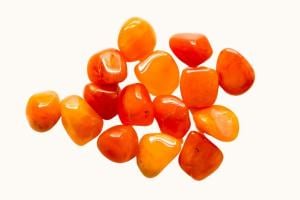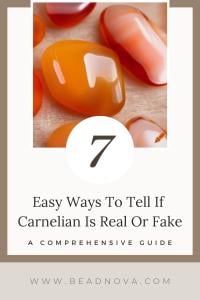Carnelian, a variety of the mineral chalcedony, is a popular and beautiful gemstone known for its deep red to orange hues. As with any valuable gemstone, it’s essential to know how to tell if carnelian is real to ensure you’re getting your money’s worth. This article aims to help readers identify real vs fake carnelian at home by outlining seven easy methods.
Table of Contents
Understanding the Characteristics of Carnelian

Before we delve into various tests, it’s crucial to understand the physical properties of carnelian that can help in identifying real carnelian. Carnelian typically has a waxy luster and exhibits a translucent to opaque appearance. Its color can range from pale orange to a deep reddish-brown, and it may even have white or gray inclusions.
A Comprehensive Guide to Tell If Your Carnelian Is Real or Fake
1. The Scratch Test
One effective method for determining the authenticity of carnelian is the scratch test. On the Mohs hardness scale, carnelian rates between 6 and 7, meaning that it is relatively hard and resistant to scratches. To perform this test, gently scratch the surface of the stone with an item of similar hardness, such as a steel file. If the stone is easily scratched, it may indicate that it’s fake. However, be cautious when performing this test, as it may damage the stone. Remember, how to tell if carnelian is fake often requires a combination of tests, so don’t solely rely on the scratch test for a definitive answer.
2. The Heat Test
The heat test is another technique that can help you differentiate between real vs fake carnelian. Genuine carnelian is known for its heat resistance, whereas its imitations might react differently to heat exposure. To perform the heat test, carefully heat the stone with a lighter or candle for a few seconds and then let it cool. If the stone’s color changes or the surface cracks, it might be a fake. Be cautious when performing this test, as it can be hazardous and may cause damage to the stone.
3. The Transparency Test
Examining the transparency of the stone can be a valuable indicator in determining the authenticity of carnelian. Genuine carnelian is generally translucent, while fake carnelian may appear more transparent or opaque. To perform the transparency test, hold the stone against a light source and observe the light passing through. If the stone is unusually transparent or doesn’t allow any light to pass through, it may be an imitation.
4. The Weight Test
Another method to how to identify carnelian is by comparing its weight to that of a known genuine sample or its imitations. Real carnelian will typically feel heavier than its fake counterparts made from materials like glass or plastic. To perform the weight test, hold the stone in your hand and assess its weight relative to its size. If the stone feels unexpectedly light or heavy, it may be a sign that it’s not genuine.
5. The Streak Test
The streak test can be a helpful tool for identifying real carnelian. To perform the streak test, rub the stone against an unglazed porcelain tile, known as a streak plate, and observe the color of the streak left behind. Genuine carnelian will leave a white or colorless streak, while fake carnelian may leave a colored streak. Keep in mind that how to tell if carnelian is fake involves using multiple tests, so the streak test should be considered along with other methods for a more accurate assessment.
6. The Cold Test
Another simple yet effective way to identify real carnelian is the cold test. Genuine carnelian, being a natural stone, tends to feel cool to the touch, even in warm environments. Imitations, on the other hand, may not exhibit this characteristic. To perform the cold test, hold the stone in your hand for a few seconds and observe its temperature. If it quickly warms up and does not retain a cool sensation, it may be a sign that the carnelian is not genuine. Keep in mind that this test should be used in conjunction with other methods for a more accurate assessment.
7. Consulting a Professional
While the tests mentioned above can be helpful in determining the authenticity of carnelian, it’s always a good idea to consult a professional, especially for high-value pieces. Gemologists, reputable jewelers, and mineralogists are experts who can accurately assess your stone’s authenticity. Remember, there’s no substitute for professional expertise, so if you’re ever unsure, seek expert advice to confirm your findings.
Spotting Common Carnelian Imitations and Their Characteristics
To further enhance your ability to identify real vs fake carnelian, it’s helpful to be aware of the common imitations and their specific characteristics. Here are some materials commonly used to mimic carnelian and how they differ from the genuine article.
Glass Imitations
Glass is a widespread material used to create fake carnelian. These imitations can be quite convincing, but there are a few key differences to look out for:
- Bubbles: Glass imitations may have tiny bubbles trapped within the material, which are not present in genuine carnelian.
- Mold marks: Some glass imitations may have mold marks or seams, indicating that the stone was formed in a mold.
- Consistent color: Glass imitations often have a more consistent color throughout the stone, whereas real carnelian may exhibit subtle color variations or banding
Dyed Agate
Dyed agate is another common imitation of carnelian. Agate is a close relative of carnelian and can be dyed to mimic its distinctive color. To identify dyed agate:
- Uneven color distribution: Dyed agate may have uneven color distribution or concentrated areas of color, as the dye may not penetrate the stone uniformly.
- Surface dye: If the stone has been poorly dyed, you might notice traces of dye on the surface, which can be a clear sign of an imitation.
- Acid test: A risky but effective method to detect dyed agate is the acid test. Apply a small drop of hydrochloric acid to an inconspicuous area of the stone. If the stone’s color changes or fades, it’s likely dyed. Exercise extreme caution when performing this test, as it can be dangerous and may damage the stone.
Plastic or Resin Imitations
Plastic or resin imitations of carnelian are less common but can still be found. These materials are lighter and less durable than genuine carnelian. Here are some ways to differentiate them from real carnelian:
- Weight: Plastic or resin imitations will feel significantly lighter than genuine carnelian.
- Warm to the touch: Unlike genuine carnelian, which feels cool to the touch, plastic or resin imitations may quickly warm up when held.
- Low resistance to heat: As mentioned in the heat test, plastic or resin imitations may react differently to heat, such as melting or emitting an odor.
Conclusion
In addition to the seven methods discussed earlier, being aware of common carnelian imitations and their characteristics can further improve your ability to identify real vs fake carnelian. Always remember to use caution when performing tests that may damage your stone and consider seeking professional advice when in doubt.
By following these guidelines and being vigilant when purchasing carnelian, you can ensure that you’re investing in a genuine, high-quality gemstone. With this knowledge in hand, you can confidently navigate the world of carnelian and make informed decisions about your gemstone purchases.
More articles about gemstones you like:
Carnelian Meaning and Healing Properties
Can Carnelian Go In The Water? The Ultimate Guide For Beginners
Red Agate Vs. Carnelian: What’s The Difference?
The Ultimate Guide To Using Healing Crystal For Beginners
5 Easy Ways on How to Tell if Amethyst is Real or Fake
7 Ways On How to Tell If Your Clear Quartz Is Real or Fake
6 Ways to Tell If Your Rose Quartz Is Real
How To Tell If The Turquoise Is Real?





Leave A Comment